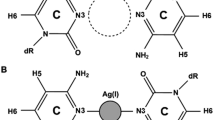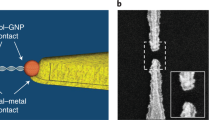Abstract
Molecular wires show promise in nanoscale electronics, but the synthesis of uniform, long conductive molecules is a significant challenge. Deoxyribonucleic acid (DNA) of precise length, by contrast, is synthesized easily, but its conductivity over the distances required for nanoscale devices has not been explored. Here we demonstrate DNA charge transport (CT) over 34 nm in 100-mer monolayers on gold. Multiplexed gold electrodes modified with 100-mer DNA yield sizable electrochemical signals from a distal, covalent Nile Blue redox probe. Significant signal attenuation upon incorporation of a single base-pair mismatch demonstrates that CT is DNA-mediated. Efficient cleavage of these 100-mers by a restriction enzyme indicates that the DNA adopts a native conformation accessible to protein binding. Similar electron-transfer rates measured through 100-mer and 17-mer monolayers are consistent with rate-limiting electron tunnelling through the saturated carbon linker. This DNA-mediated CT distance of 34 nm surpasses that of most reports of molecular wires.
This is a preview of subscription content, access via your institution
Access options
Subscribe to this journal
Receive 12 print issues and online access
$259.00 per year
only $21.58 per issue
Buy this article
- Purchase on Springer Link
- Instant access to full article PDF
Prices may be subject to local taxes which are calculated during checkout





Similar content being viewed by others
References
Robertson, N. & McGowan, C. A. A comparison of potential molecular wires as components for molecular electronics. Chem. Soc. Rev. 32, 96–103 (2003).
Chen, F. & Tao, N. J. Electron transport in single molecules: from benzene to graphene. Acc. Chem. Res. 42, 429–438 (2009).
Malliaras, G. & Friend, R. An organic electronics primer. Phys. Today 58, 53–58 (2005).
Tuccitto, N. et al. Highly conductive ~40-nm-long molecular wires assembled by stepwise incorporation of metal centres. Nature Mater. 8, 41–46 (2009).
Choi, S. H., Kim, B. & Frisbie, C. D. Electrical resistance of long conjugated molecular wires. Science 320, 1482–1486 (2008).
Liu, L. & Frisbie, C. D. Length-dependent conductance of conjugated molecular wires synthesized by stepwise ‘click’ chemistry. J. Am. Chem. Soc. 132, 8854–8855 (2010).
Søndergaard, R. et al. Conjugated 12 nm long oligomers as molecular wires in nanoelectronics. J. Mater. Chem. 19, 3899–3908 (2009).
Hu, W. et al. Electron transport in self-assembled polymer molecular junctions. Phys. Rev. Lett. 96, 027801 (2006).
Vura-Weis, J. et al. Crossover from single-step tunneling to multistep hopping for molecular triplet energy transfer. Science 328, 1547–1550 (2010).
Drummond, T. G., Hill, M. G. & Barton, J. K. Electrochemical DNA sensors. Nature Biotechnol. 21, 1192–1199 (2003).
Liu, J., Cao, Z. & Lu, Y. Functional nucleic acid sensors. Chem. Rev. 109, 1948–1998 (2009).
Endres, R. G., Cox, D. L. & Singh, R. R. P. Colloquium: the quest for high-conductance DNA. Rev. Mod. Phys. 76, 195–214 (2004).
Roy, S. et al. Direct electrical measurements on single-molecule genomic DNA using single-walled carbon nanotubes. Nano Lett. 8, 26–30 (2008).
Murphy, C. J. et al. Long-range photoinduced electron transfer through a DNA helix. Science 262, 1025–1029 (1993).
Fink, H. W. & Schoenberger, C. Electrical conduction through DNA molecules. Nature 398, 407–410 (1999).
de Pablo, P. J. et al. Absence of dc-conductivity in λ-DNA. Phys. Rev. Lett. 85, 4992–4995 (2000).
Kasumov, A. et al. Proximity-induced superconductivity in DNA. Science 291, 280–282 (2001).
Storm, A. J., van Noort, J., de Vries, S. & Dekker, C. Insulating behavior for DNA molecules between nanoelectrodes at the 100 nm length scale. Appl. Phys. Lett. 79, 3881–3883 (2001).
Guo, X., Gorodetsky, A. A., Hone, J., Barton, J. K. & Nuckolls, C. Conductivity of a single DNA duplex bridging a carbon nanotube gap. Nature Nanotech. 3, 163–167 (2008).
Kelley, S. O. & Barton, J. K. Electron transfer between bases in double helical DNA. Science 283, 375–381 (1999).
Cohen, H., Nogues, C., Naaman, R. & Porath, D. Direct measurement of electrical transport through single DNA molecules of complex sequence. Proc. Natl Acad. Sci. USA 102, 11589–11593 (2005).
Xu, B., Zhang, P., Li, X. & Tao, N. Direct conductance measurement of single DNA molecules in aqueous solution. Nano Lett. 4, 1105–1108 (2004).
Kelley, S. O., Holmlin, R. E., Stemp, E. D. A. & Barton, J. K. Photoinduced electron transfer in ethidium-modified DNA duplexes: dependence on distance and base stacking. J. Am. Chem. Soc. 119, 9861–9870 (1997).
Kelley, S. O., Boon, E. M., Barton, J. K., Jackson, N. M. & Hill, M. G. Single-base mismatch detection based on charge transduction through DNA. Nucleic Acids Res. 27, 4830–4837 (1999).
Boon, E. M., Ceres, D. M., Drummond, T. G., Hill, M. G. & Barton, J. K. Mutation detection by electrocatalysis at DNA-modified electrodes. Nature Biotechnol. 18, 1096–1100 (2000).
Núñez, M. E., Hall, D. B. & Barton, J. K. Long-range oxidative damage to DNA: effects of distance and sequence. Chem. Biol. 6, 85–97 (1999).
Boon, E. M., Salas, J. E. & Barton, J. K. An electrical probe of protein–DNA interactions on DNA-modified surfaces. Nature Biotechnol. 20, 282–286 (2002).
Genereux, J. C. & Barton, J. K. Mechanisms for DNA charge transport. Chem. Rev. 110, 1642–1662 (2010).
Wagenknecht, H.-A. Charge Transfer in DNA: From Mechanism to Application (Wiley, 2005).
Kawai, K., Kodera, H., Osakada, Y & Majima, T. Sequence-independent and rapid long-range charge transfer through DNA. Nature Chem. 1, 156–159 (2009).
Douglas, S. M. et al. Self-assembly of DNA into nanoscale three-dimensional shapes. Nature 459, 414–418 (2009).
Rothemund, P. W. K. Folding DNA to create nanoscale shapes and patterns. Nature 440, 297–302 (2006).
Soleymani, L. et al. Programming the detection limits of biosensors through controlled nanostructuring. Nature Nanotech. 4, 844–848 (2010).
Slinker, J. D., Muren, N. B., Gorodetsky, A. A. & Barton, J. K. Multiplexed DNA-modified electrodes. J. Am. Chem. Soc. 132, 2769–2774 (2010).
Gorodetsky, A. A., Ebrahim, A. & Barton, J. K. Electrical detection of TATA binding protein at DNA-modified microelectrodes. J. Am. Chem. Soc. 130, 2924–2925 (2008).
Liu, T. & Barton, J. K. DNA electrochemistry through the base pairs not the sugar-phosphate backbone. J. Am. Chem. Soc. 127, 10160–10161 (2005).
Kelley, S. O. et al. Orienting DNA helices on gold using applied electric fields. Langmuir 14, 6781–6784 (1998).
Sam, M., Boon, E. M., Barton, J. K., Hill, M. G. & Spain, E. M. Morphology of 15-mer duplexes tethered to Au(111) probed using scanning probe microscopy. Langmuir 17, 5727–5730 (2001).
Boal, A. K. & Barton, J. K. Electrochemical detection of lesions in DNA. Bioconjugate Chem. 16, 312–321 (2005).
Laviron, E. General expression of the linear potential sweep voltammagram in the case of diffusionless electrochemical systems. J. Electroanal. Chem. 101, 19–28 (1979).
Weber, K., Hockett, L. & Creager, S. Long-range electronic coupling between ferrocene and gold in alkanethiolate-based monolayers on electrodes. J. Phys. Chem. B 101, 8286–8291 (1997).
Huang, K. et al. Ferrocene and porphyrin monolayers on Si(100) surfaces: preparation and effect of linker length on electron transfer. ChemPhysChem 10, 963–971 (2009).
Yu, H. Z., Shao, H. B., Luo, Y., Zhang, H. L. & Liu, Z. F. Evaluation of the tunneling constant for long range electron transfer in azobenzene self-assembled monolayers on gold. Langmuir 13, 5774–5778 (1997).
Boon, E. M. & Barton, J. K. Reduction of ferricyanide by methylene blue at a DNA-modified rotating-disk electrode. Langmuir 19, 9255–9259 (2003).
Kelley, S. O., Jackson, N. M., Hill, M. G. & Barton, J. K. Long-range electron transfer through DNA films. Angew. Chem. Int. Ed. 38, 941–945 (1999).
Gorodetsky, A. A., Green, O., Yavin, E. & Barton, J. K. Coupling into the base pair stack is necessary for DNA-mediated electrochemistry. Bioconjugate Chem. 18, 1434–1441 (2007).
Drummond, T. G., Hill, M. G. & Barton, J. K. Electron transfer rates in DNA films as a function of tether length. J. Am. Chem. Soc. 126, 15010–15011 (2004).
Arikuma, Y., Nakayama, H., Morita, T. & Kimura, S. Electron hopping over 100 Å along an α-helix. Angew. Chem. Int. Ed. 49, 1800–1804 (2010).
Steenken, S., Telo, J. P., Novais, H. M. & Candeias, L. P. One-electron-reduction potentials of pyrimidine bases, nucleosides, and nucleotides in aqueous solution. Consequences for DNA redox chemistry. J. Am. Chem. Soc. 114, 4701–4709 (1992).
Genereux, J. C., Augustyn, K. E., Davis, M. L., Shao, F. & Barton, J. K. Back-electron transfer suppresses the periodic length dependence of DNA-mediated charge transport across adenine tracts. J. Am. Chem. Soc. 130, 15150–15156 (2008).
Acknowledgements
This research was supported by the National Institutes of Health (GM61077). J.D.S. also thanks the National Institute of Biomedical Imaging and Bioengineering for a postdoctoral fellowship (F32EB007900). The authors thank J. Genereux, A. Gorodetsky and M. Buzzeo for discussions, and K. Kan for assistance with the fabrication of the silicon chips. This work was completed in part in the Caltech Micro Nano Fabrication Laboratory.
Author information
Authors and Affiliations
Contributions
J.K.B., J.D.S. and N.B.M. conceived and designed the experiments. J.D.S., N.B.M. and S.E.R. carried out the experiments. J.D.S., N.B.M. and J.K.B. analysed the results and co-wrote the paper.
Corresponding author
Ethics declarations
Competing interests
The authors declare no competing financial interests.
Supplementary information
Supplementary information
Supplementary information (PDF 482 kb)
Rights and permissions
About this article
Cite this article
Slinker, J., Muren, N., Renfrew, S. et al. DNA charge transport over 34 nm. Nature Chem 3, 228–233 (2011). https://doi.org/10.1038/nchem.982
Received:
Accepted:
Published:
Issue Date:
DOI: https://doi.org/10.1038/nchem.982
This article is cited by
-
Molecular Tetris by sequence-specific stacking of hydrogen bonding molecular clips
Communications Chemistry (2022)
-
Printable logic circuits comprising self-assembled protein complexes
Nature Communications (2022)
-
High-sensitive ferrocene labeled aptasensor for the detection of Mucin 1 by tuning the sequence constitution of complementary probe
Microchimica Acta (2022)
-
From molecular to supramolecular electronics
Nature Reviews Materials (2021)
-
Redox-Active Ferrocene grafted on H-Terminated Si(111): Electrochemical Characterization of the Charge Transport Mechanism and Dynamics
Scientific Reports (2019)



